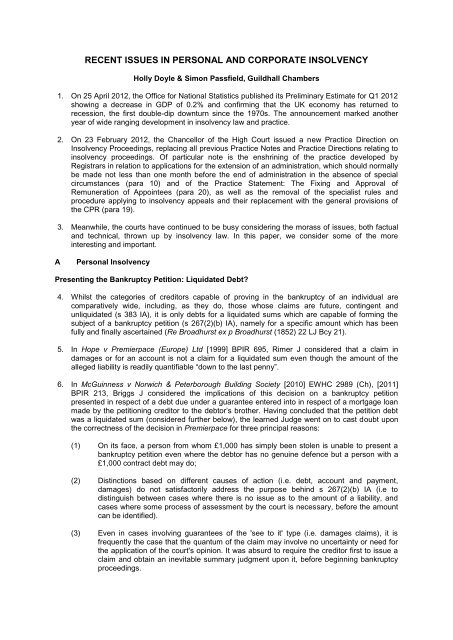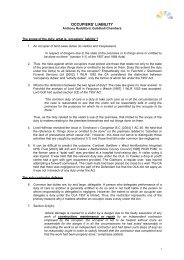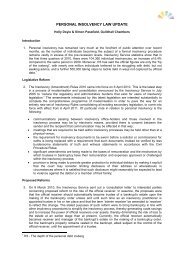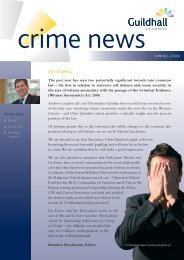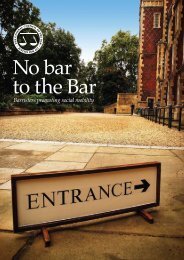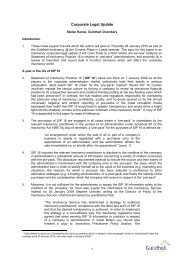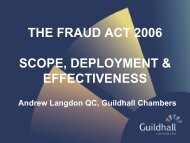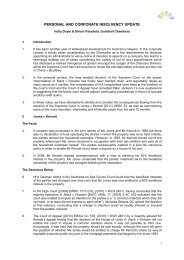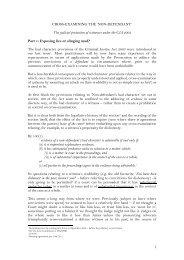Personal and Corporate Update - Holly Doyle & Simon Passfield
Personal and Corporate Update - Holly Doyle & Simon Passfield
Personal and Corporate Update - Holly Doyle & Simon Passfield
Create successful ePaper yourself
Turn your PDF publications into a flip-book with our unique Google optimized e-Paper software.
RECENT ISSUES IN PERSONAL AND CORPORATE INSOLVENCY<strong>Holly</strong> <strong>Doyle</strong> & <strong>Simon</strong> <strong>Passfield</strong>, Guildhall Chambers1. On 25 April 2012, the Office for National Statistics published its Preliminary Estimate for Q1 2012showing a decrease in GDP of 0.2% <strong>and</strong> confirming that the UK economy has returned torecession, the first double-dip downturn since the 1970s. The announcement marked anotheryear of wide ranging development in insolvency law <strong>and</strong> practice.2. On 23 February 2012, the Chancellor of the High Court issued a new Practice Direction onInsolvency Proceedings, replacing all previous Practice Notes <strong>and</strong> Practice Directions relating toinsolvency proceedings. Of particular note is the enshrining of the practice developed byRegistrars in relation to applications for the extension of an administration, which should normallybe made not less than one month before the end of administration in the absence of specialcircumstances (para 10) <strong>and</strong> of the Practice Statement: The Fixing <strong>and</strong> Approval ofRemuneration of Appointees (para 20), as well as the removal of the specialist rules <strong>and</strong>procedure applying to insolvency appeals <strong>and</strong> their replacement with the general provisions ofthe CPR (para 19).3. Meanwhile, the courts have continued to be busy considering the morass of issues, both factual<strong>and</strong> technical, thrown up by insolvency law. In this paper, we consider some of the moreinteresting <strong>and</strong> important.A<strong>Personal</strong> InsolvencyPresenting the Bankruptcy Petition: Liquidated Debt?4. Whilst the categories of creditors capable of proving in the bankruptcy of an individual arecomparatively wide, including, as they do, those whose claims are future, contingent <strong>and</strong>unliquidated (s 383 IA), it is only debts for a liquidated sums which are capable of forming thesubject of a bankruptcy petition (s 267(2)(b) IA), namely for a specific amount which has beenfully <strong>and</strong> finally ascertained (Re Broadhurst ex p Broadhurst (1852) 22 LJ Bcy 21).5. In Hope v Premierpace (Europe) Ltd [1999] BPIR 695, Rimer J considered that a claim indamages or for an account is not a claim for a liquidated sum even though the amount of thealleged liability is readily quantifiable “down to the last penny”.6. In McGuinness v Norwich & Peterborough Building Society [2010] EWHC 2989 (Ch), [2011]BPIR 213, Briggs J considered the implications of this decision on a bankruptcy petitionpresented in respect of a debt due under a guarantee entered into in respect of a mortgage loanmade by the petitioning creditor to the debtor’s brother. Having concluded that the petition debtwas a liquidated sum (considered further below), the learned Judge went on to cast doubt uponthe correctness of the decision in Premierpace for three principal reasons:(1) On its face, a person from whom £1,000 has simply been stolen is unable to present abankruptcy petition even where the debtor has no genuine defence but a person with a£1,000 contract debt may do;(2) Distinctions based on different causes of action (i.e. debt, account <strong>and</strong> payment,damages) do not satisfactorily address the purpose behind s 267(2)(b) IA (i.e todistinguish between cases where there is no issue as to the amount of a liability, <strong>and</strong>cases where some process of assessment by the court is necessary, before the amountcan be identified).(3) Even in cases involving guarantees of the 'see to it' type (i.e. damages claims), it isfrequently the case that the quantum of the claim may involve no uncertainty or need forthe application of the court's opinion. It was absurd to require the creditor first to issue aclaim <strong>and</strong> obtain an inevitable summary judgment upon it, before beginning bankruptcyproceedings.
7. In the recent appeal [2011] EWCA Civ 1286, [2012] BPIR 1286, the Court of Appeal has had theopportunity to provide further guidance in the matter.8. Patten LJ, giving the leading judgment (with which Ward <strong>and</strong> Moses LJJ agreed), identified fourtypes of liability which may be imposed on a guarantor by a guarantee of a loan:(1) An undertaking by the guarantor that the principal debtor will perform his own contractwith the creditor (a ‘see to it’ obligation);(2) A promise by the guarantor to pay the instalments of principal <strong>and</strong> interest which fall dueif the principal debtor fails to make those payments (a ‘conditional payment’ obligation);(3) An indemnity;(4) A concurrent liability with the debtor for what is due under the contract of loan.9. It was common ground that obligations in classes (2) <strong>and</strong> (4) create a liability in debt <strong>and</strong> thatobligations in class (3) are enforceable by way of action in unliquidated damages.10. The key issue before the court was whether an obligation in class (1) constituted a debt for aliquidated sum notwithst<strong>and</strong>ing that it creates a liability in damages (Moschi v Lep Air Services<strong>and</strong> Others [1973] AC 331), albeit one which is readily ascertainable by reference to the state ofaccount between the creditor <strong>and</strong> the principal debtor.11. Having conducted an exhaustive examination of the relevant authorities under previouslegislation including the Bankruptcy Acts 1849, 1861, 1869 <strong>and</strong> 1914, Patten LJ concluded that adebt for a liquidated sum must be a pre-ascertained liability under the agreement which givesrise to it (which can include a contractual claim for liquidated damages). For this reason,Premierpace was correctly decided on its facts.12. Turning to the application of the relevant principle to guarantees, the key issue is whether theliability of the guarantor can be treated as one which is reduced to <strong>and</strong> specified <strong>and</strong> agreed bythe guarantee itself. Since a ‘see to’ it obligation gives rise to a claim for unliquidated damages,although the measure of liability is the amount of the principal’s debt, that is not the same as anobligation to pay a sum of money under the contract whether as debt or agreed damages (whichdoes arise in relation to a conditional payment obligation).13. In the instant case, it was accepted that clause 2.4 of the guarantee amounted to an indemnitygiving rise to a claim for unliquidated damages <strong>and</strong> not a debt for a liquidated sum. However, itwas necessary to determine whether, on a proper analysis, clauses 2.2-2.3 <strong>and</strong>/or 4.2 imposedan additional obligation in classes (2) or (4), <strong>and</strong> hence a debt for a liquidated sum:Cl 2.2 Provided that the guarantor guaranteed all money <strong>and</strong> liabilities owing by the principaldebtor would be paid <strong>and</strong> satisfied when due;Cl 2.3 Provided that any amount claimed under the Guarantee was payable by the guarantorimmediately on dem<strong>and</strong> by the creditor.Cl 4.2 Provided that the guarantor’s obligations under the guarantor were those of principal <strong>and</strong>not just as surety. The creditor was not obliged to make dem<strong>and</strong> on, or take any stepsagainst, the principal debtor or any other person before enforcing the guarantee.14. Patten LJ concluded on balance that clause 2.2 gave rise to a conditional payment obligation onthe basis that:(1) The admitted damages obligation under clause 2.4 was stated to be a separateobligation <strong>and</strong> extended to any shortfall in the payment by the principal of the mortgagedebt, therefore overlapping with the liabilities covered by cl 2.2. Clause 2.4 would beunnecessary if the primary liability under cl 2.2 was simply a ‘see to it’ obligation;
(2) Cl 2.3 makes the sums due under the guarantee payable on dem<strong>and</strong>. Notice is not a prerequisiteto the enforcement of a liability in damages. Cl 2.3 is more consistent with cl2.2. being read as a direct promise to pay the mortgage liabilities as they fall due.15. Though strictly unnecessary, Patten LJ went on to consider Briggs J’s conclusion that the effect ifcl 4.2 was to make the mortgage debt that of the guarantor, holding that the provisions of cl 4.2merely operated to confirm that where any of the obligations of clause 2 are capable of takingeffect as a liability in debt, the liability of the guarantor is concurrent with that of the principal <strong>and</strong>not contingent upon it.16. The cumulative effect of these findings was that cl 2.2 created an obligation in class (4) <strong>and</strong> wastherefore a debt for a liquidated sum capable of forming the subject of a bankruptcy petition.17. This decision is also likely to have an impact on the voting rights of lenders in IVAs <strong>and</strong> CVAs,since a debt for an unliquidated amount his debt will be valued at £1 unless the chairman agreesto put a higher value on it (r 1.17(3); r 5.21(3) IR). Nevertheless, given that the damages to whicha creditor is entitled in respect of a ‘see to it’ obligation is readily ascertainable, it is likely that itwill be appropriate in all the circumstances for the supervisor to permit the creditor to vote for fullvalue (where the debt is not disputed on substantial grounds <strong>and</strong> there is no counterclaim, crossdem<strong>and</strong> or set-off).Dismissal of the Petition: further guidance on when the rejection of an offer of security isunreasonable.18. In HM Revenue <strong>and</strong> Customs <strong>and</strong> Steven Garwood (not yet reported) Mr Registrar Baisterconducted a thorough review of the authorities on section 271(3) <strong>and</strong> the question of when anoffer to secure a petition debt is unreasonably refused, <strong>and</strong> gave a very helpful summary of theprinciple propositions that emerge.19. The case concerned a petition presented by HMRC on 2 August 2010 against G for anundisputed debt of £58,432.20. On the 9 September 2010 G’s solicitors wrote to HMRC confirming that G was a joint owner of aproperty with Miss Thompson, giving approximate redemption figures for the existing charges<strong>and</strong> calculating G had equity in the region of £113,000 - 118,000 in the property. The letter statedG was prepared to offer a charge to secure the petition debt over his beneficial interest. Theletter included office copy entries of the title <strong>and</strong> a valuation. The redemption figures wereupdated <strong>and</strong> confirmed in a letter dated 13 September 201021. The first hearing of the petition took place 20 September 2010. G’s solicitor produced a witnessstatement which explained that the property was worth £390,000 - 400,000, that after takingaccount of charges G’s share of the equity would be in the region of £114,000 <strong>and</strong> as a result ofa dispute between himself <strong>and</strong> Miss Thompson there was already an order for sale dated 14December 2009. The petition was adjourned for G to raise a loan against the property or for itssale <strong>and</strong> for the petition debt to be settled.22. The second hearing took place on 1 November 2010. G’s solicitor produced a second witnessstatement reporting that Miss Thompson had been ordered to give vacant possession of theproperty by 27 October 2010 <strong>and</strong> the property was on the market. The petition was againadjourned.23. On 17 February G gave formal notice of opposition referring to the offer of security. On 18February 2011 the third hearing of the petition was further adjourned. G’s solicitor filed a witnessstatement stating that the asking price had been reduced to £385,000. At this stage it hademerged that Miss Thompson was bankrupt.24. On 4 March 2011 the fourth hearing of the petition was adjourned to enable the petitioningcreditor to consider the offer of security <strong>and</strong> for sale of the property. On 11 March 2011 HMRCwrote a letter rejecting the offer of security <strong>and</strong> asserting that a creditor was not obliged to takesecurity offered by a debtor “however good it may be”.
25. On 10 May 2011 the sixth hearing was adjourned for sale on a final basis.26. On 5 July 2011 the seventh hearing as used as a directions hearing. G’s solicitor filed a witnessstatement stating that the court had determined that the debtor had a 50% interest in the property<strong>and</strong> the debtor offered to pay £200 per week reduction in the balance pending sale. On 2 August2011 the petitioning creditor filed their evidence in response. The evidence submitted refusal ofthe offer was not unreasonable because G had had a considerable amount of time to sell hisproperty <strong>and</strong> the offer proposed would merely see HMRC rank alongside other charges pendingsale.27. On 5 October 2011 further directions were given at the eighth hearing, but which time MissThompson had been ordered to vacate the property within 14 days of service of the order <strong>and</strong>the price of the property had gone down to £365,000.28. On 20 February 2012 the G’s solicitor put in a final (eighth!) witness statement stating that theasking price had been reduced to a guide price of £300,000 - 350,000, that 3 offers had beenmade, the highest being £300,000, <strong>and</strong> that G could expect to receive £72,000 on sale.29. At the final hearing HMRC submitted that (1) there was a history of delay (2) there was a historyof disorder in G’s tax affairs (3) G had had plenty of time to finance his tax debts <strong>and</strong> to sell hisproperty but there was no guarantee as to when a sale would take place (4) HMRC had astatutory obligation to collect tax <strong>and</strong> was entitled to have regard to its own interests in how it didso <strong>and</strong> (5) HMRC did not have the resources to act as mortgagee <strong>and</strong> oversee a sale - its taskwas to collect tax <strong>and</strong> not act as lender.30. Counsel for G relied upon the adequacy of the security, the fact that there was already an orderfor sale <strong>and</strong> the property was vacant <strong>and</strong> the fact that the duty to collect tax would be betterserved by a charge <strong>and</strong> sale since the recovery would be quicker <strong>and</strong> greater without theinvolvement of a trustee.31. Mr Registrar Baister reviewed the authorities on section 127(3) IA 1986 including Re a Debtor(No 32 of 1993) [1994] 1 WLR 899), HM Customs & Excise v Dougall [2001] BPIR <strong>and</strong> Ross vRevenue <strong>and</strong> Customs Commissioners [2010] 2 All ER 126 <strong>and</strong> gave the principle propositionsthat emerged (non exhaustively) as (at para 23):(1) The starting point is to ask whether a reasonable hypothetical creditor in theposition of the petitioning creditor would accept or refuse the offer, bearing inmind, however, that there could be a range of reasonable positions which sucha creditor could adopt;(2) The test is objective;(3) It is necessary to consider the extent to which the reasonable hypotheticalcreditor may be taken to have the characteristics of the petitioning creditor;(4) The court must look at the position at the date of the hearing;(5) The court is not limited to considering the matters taken into account by thepetitioning creditor when the offer of security was refused; it must look at allthe relevant factors <strong>and</strong> their impact of the reasonable hypothetical creditor;(6) That includes the history;(7) The debtor must be full, frank <strong>and</strong> open in providing the necessary informationto enable the creditor to make an informed decision;(8) A rigid institutional policy of rejecting offers to secure could be a relevantconsideration, since the reasonable hypothetical creditor was obliged toconsider an offer on its merits. “Coherent in-house policies” however, are notnecessarily wrong.(9) A creditor is entitled to have regard to his own interests <strong>and</strong> is not obliged to“take a chance, or to show patience or generosity”.(10) The costs <strong>and</strong> resources implications for the creditor are a “highly materialconsideration”.
32. The Registrar then applied these principles. He found that HMRC’s written rejection on 11 March2011 was wrong on the law <strong>and</strong> appeared to have been a galvanic reaction reflecting“thoughtless bureaucratic inflexibility” with no thought having been applied to the merits of theproposal. It was therefore unreasonable in <strong>and</strong> of itself.33. However, the Registrar accepted he should not look only at the reasons the petitioner gave forrejecting the offer but at the history <strong>and</strong> the present position.(1) He agreed that there had been history of delay <strong>and</strong> the number of adjournments wasunusual but there was no indication of prevarication by G. On the contrary G had takenactive steps through the courts <strong>and</strong> otherwise to sell the property <strong>and</strong> the most he couldbe criticised for was holding out at too high an asking price for too long. Further the offerof security in this case was different from that in Dougall <strong>and</strong> Ross because the offer wasfor an immediate sale <strong>and</strong> neither G nor any other person would be able to make anydifficulty about an order for sale.(2) A history of disorder in G’s tax affairs was not set out in the evidence but even if true itwas a sign of incompetence <strong>and</strong> a far cry from the sort of fraud perpetrated in Dougallwhich the Registrar could readily accept would be a factor which a petitioner would beentitled to take into account in assessing a debtor’s offer.(3) It was hard to see how HMRC would be put to any or any serious cost or would have todivert resources or act as mortgagee or administer the sale of the mortgaged property.Further the recent offers of purchase indicate that HMRC would not have to put up withthe inconvenience of taking security for long, <strong>and</strong> if it appeared the sale would beprotracted, it could exercise its right to seek an order for sale as well as its costs of theorder <strong>and</strong> overseeing the sale all of which could be provided for in the charge togetherwith any interest due.(4) While it is relevant that HMRC’s primary function is to collect tax <strong>and</strong> it has a statutoryobligation to do so, these considerations do not trump everything else, they are merelyfactors to be weighed in the balance: otherwise there would be no discretion to exercise.(5) The alternative to taking security is by making G bankrupt. If a bankruptcy order is made(a) A trustee would be appointed whose fees are likely to be not insignificant, (b) Advalorem fees would have to be paid (c) the trustee might not seek a sale until one yearafter the vesting of the estate <strong>and</strong> (d) HMRC would be unsecured.34. It was fairly certain that the bankruptcy costs would be greater than those attendant on thealternative <strong>and</strong> there was no countervailing benefit to bankruptcy because there was noindication HMRC sought an investigation of G’s affairs or any antecedent transactions.35. Applying the objective test the reasonable hypothetical creditor could have no basis for refusingthe offer of security <strong>and</strong> pressing for a bankruptcy order, <strong>and</strong> subject to the terms of the chargebeing agreed <strong>and</strong> the charge being entered into (for which the petition was adjourned for a finaltime) the Registrar would dismiss the petition.Income Payments Orders (IPOs): Is a bankrupt’s undrawn pension entitlement ‘income’?36. The trustee’s rights in relation to a bankrupt’s pension schemes have undergone significantchange in the last 15 years. First came the decision in re L<strong>and</strong>au (A bankrupt) [1998] Ch 223, inwhich Ferris J considered the question whether benefits under a pension policy which becamepayable after the bankrupt’s discharge are payable to the bankrupt or to the trustee. He ruledthat:(1) the bankrupt’s bundle of contractual rights under a pension policy was a chose in action at thetime of the bankruptcy order <strong>and</strong> therefore constituted “property” within section 436 IA 1986which vested automatically in the trustee on his appointment pursuant to section 306 IA 1986. Itdid not matter that at the commencement of the bankruptcy nothing was immediatelypayable/recoverable by action, because at the time of the bankruptcy order the bankrupt had a
present right to compel the trustees of his pension to make payments under the policy in thefuture;(2) Section 310 IA 1986 (as it then stood) does not apply to property or income which alreadyvests in the trustee pursuant to section 306 IA 1986;(3) Therefore the right to payment of the annuity payable under the policy vested in the trustee onhis appointment <strong>and</strong> section 310 IA 1986 had no application to it when it became payable.Further, after the right to receive the annuity under the policy vested in the trustee he was theonly person entitled to exercise the options conferred by the policy on the annuitant <strong>and</strong> couldtherefore exercise the option to commute part of the annuity into a lump sum.37. Following this decision it became the practice of trustees to lay claim to a bankrupt’s right in hispension <strong>and</strong> to exercise the rights of the bankrupt under the policy as they saw fit.38. The decision prompted a legislative response in Section 11 of the Welfare Reform <strong>and</strong> PensionsAct 1999, which provides that (where a bankruptcy order is made against a person on a petitionpresented after the coming into force of the section) the bankrupt’s rights under an approvedpension arrangement are excluded from his estate. The “bundle of contractual rights” <strong>and</strong>benefits of the bankrupt’s pension policy therefore no longer vests in a trustee upon hisappointment but remains vested in the bankrupt.39. At the same time the partial definition of the bankrupt’s “income” in section 310(7) of the IA 1986(dealing with IPOs) was amended to include:“ every payment in the nature of income which is from time to time made to him or to which hefrom time to time becomes entitled, including…(despite anything in s 11 or 12 of the welfareReform <strong>and</strong> Pensions Act 1999) any payment under a pension scheme…” .40. It appears clear therefore that where a bankrupt has given notice to the pension fund of hiselection to take up his rights under the pension scheme, any lump sum or periodic payment hereceives remains his property save to the extent that the trustee has obtained an IPO pursuant tosection 310 IA 1986. Further, the right to elect when <strong>and</strong> how to draw his pension remains vestedin the bankrupt.41. However, the Chancery Division has recently considered the question of whether a debtor whohad not yet elected to draw his pension could nevertheless be compelled to elect to do so for thebenefit of his creditors in two decisions: Blight, Meredith <strong>and</strong> Lewis v Brewster [2012] EWHC 165(Ch) (outside the insolvency regime) <strong>and</strong> Raithatha v Williamson [2012] EWHC 909 (Ch) (withinthe insolvency regime).42. In Blight, Meredith <strong>and</strong> Lewis v Brewster [2012] EWHC 165 (Ch) the Court was called on toconsider the question whether a judgment creditor (C) could execute against the judgment’sdebtor (D)’s right to draw down 25% of his pension as a tax free sum.43. At first instance the District Judge had held that:(1) C could not apply for a third party debt order unless D had made the election to drawdown the lump sum, because until that point there was no debt, <strong>and</strong>(2) there was no jurisdiction in the Court to force D to make an election to take his lump sumwhich was not in his financial interest.44. On C’s appeal, Gabriel Moss QC reversed the decision in the court below, ordering D to delegateto C’s solicitor the power to make the election to draw the lump sum payment up to the amountneeded to repay the balance of the judgment debt in D’s name <strong>and</strong> restoring the third party debtorder discharged below, to take effect from the moment that the debt created by the election totake the lump sum became effective.45. The Judge started his reasoning from his impression that the contrary result would work asubstantial injustice to C, <strong>and</strong> that the idea that D (a fraudster <strong>and</strong> forgerer) could enjoy anenhanced st<strong>and</strong>ard of living at his retirement instead of paying a judgment debt, where he had
the means of paying the debt simply by giving notice to his pension trustees, would be a veryunattractive conclusion.46. He relied heavily on the decision of the Privy Council in Tarasarruf Mevduatii Sigorta Fonu vMerrill Lynch Bank <strong>and</strong> Trust Company (Cayman) Limited [2011] KPC 17 concerning theanalogous question whether the court had jurisdiction to order a debtor to exercise his power torevoke a trust so that he would recover from the trust substantial assets over which receiversappointed by way of equitable execution could take possession. The Privy Council consideredthat the jurisdiction to appoint a receiver by way of equitable execution was not limited to a chosein action presently available for legal execution but extended to whatever was considered inequity to be assets. The powers of revocation were such that in equity the debtor could beregarded as having rights tantamount to ownership over the trust assets. Further an injunctioncould be granted for the purpose of vesting the right of revocation in the receiver.47. Gabriel Moss QC considered that, by analogy with this reasoning, D’s ability to elect to take acash payment from his pension was such that in equity he could be regarded as having a right tothat lump sum tantamount to ownership of it <strong>and</strong> that a receiver could therefore be appointedover the right by way of equitable execution. In all the circumstances, it was not necessary to goto the disproportionate trouble <strong>and</strong> expense of appointing a receiver by way of equitableexecution <strong>and</strong> force D to delegate his power of election to draw his lump sum to the receiver -instead the power could simply be delegated to C’s solicitor.48. In coming to this conclusion, the Judge refused to follow the decision in Field v Field [2003] 1FLR 376, where the court had dismissed an application to enforce an order that a husb<strong>and</strong> paythe wife a lump sum payment by an injunction or through a Receiver by way of equitableexecution (remedies aimed at requiring the husb<strong>and</strong> to elect to take a lump sum entitlementunder a personal pension scheme) on the basis that (1) there was no income or propertybelonging to the debtor to “receive” <strong>and</strong> (2) such an injunction would be “a free st<strong>and</strong>ingenforcement procedure in its own right” not permitted by section 37 of the Supreme Courts Act1981. Although the Privy Council in Tarasarruf had sought to distinguish Field (stating that thebasis for characterisation of the injunction as “freest<strong>and</strong>ing” in that case was not clear, but in thecase before them such an order would be ancillary to the right of C as judgment creditors) in factthe two decisions were inconsistent <strong>and</strong> Field created a substantial injustice <strong>and</strong> should not befollowed.49. Further, the Judge considered that there was a strong principle <strong>and</strong> policy of justice to the effectthat debtors should not be allowed to hide their assets in pension funds when they had the rightto withdraw monies needed to pay their creditors.50. D’s counsel had urged the judge to the view that public policy requires pensions to be treated asexceptional when it comes to the execution of judgments in general. In support of this submissionhe pointed out that Parliament had seen fit in the area of bankruptcy to create special statutoryprotection for pensions. The judge rejected any such general policy relating to pensions, <strong>and</strong> said(at paragraph 72):51. “In my judgment, that suggestion is erroneous. A person who files successfully for bankruptcysurrenders all his assets, save those protected by law, to a trustee in bankruptcy for the paymentof his debts. Filing for bankruptcy is a relief from the ability of creditors individually to executeupon the debtor’s assets, in favour of collective execution. But this relief comes at a significantprice. Bankruptcy carries very important disadvantages in terms of obtaining credit <strong>and</strong> acting asa director of a limited liability company, such restrictions being designed to protect the public. Ajudgment debtor in my view cannot have the benefits of bankruptcy without its burdens. If hechooses the advantage of not being bankrupt, for example because he considers himself to besolvent, then he must pay his debts or his assets (including contingent assets subject to someact on his part) will be amenable to the enforcement of judgments by individual creditors.”52. The decision in this case implicitly acknowledged that in the bankruptcy context, a bankrupt’spension entitlement was not an asset which formed part of the bankruptcy estate available tocreditors, <strong>and</strong> the answer would have been different had D been a bankrupt.
53. Shortly thereafter, in Raithatha v Williamson [2012] EWHC 909 (Ch) (4 April 2012), the court wascalled upon to determine whether an IPO could be made where the bankrupt had an entitlementto elect to draw a pension but had not exercised it at the date of the application i.e. could thecourt compel a bankrupt to make his election or authorise the trustee to exercise that power forhim? Brewster does not appear to have been cited to the court, or was at least not considered inthe judgment.54. The facts were as follows: a bankruptcy order was made against Mr Raithatha (R) on 9November 2010 (when he was 58 years old) <strong>and</strong> a trustee appointed the following day. Thebankruptcy debts were in the order of £1,249,653.55. R’s most valuable asset was a bundle of pension policies <strong>and</strong> entitlements amounting to a fundestimated at between £900,000 <strong>and</strong> £990,000. Most of the policies were aggregated in a schemerun by the Berkely Burke Private Pension Plan. The rules of the scheme provided that theminimum age at which the pension could be taken was 55.56. The trustee in bankruptcy made enquiries of the trustees of the pension fund <strong>and</strong> was informed Rwas entitled to a tax free lump sum of up to £248,708 (at the maximum level of 25% of the overallfunds) <strong>and</strong> a pension from the residual fund which, depending on the type of pension selected,could be an annuity ranging from £23,000 - 43,000.57. R had not exercised his right to draw his pension: he was still in work <strong>and</strong> had no intention totake his pension in the foreseeable future.58. On 23 September 2011, 6 weeks before the date R was discharged from his bankruptcy, thetrustee applied to the court for an IPO <strong>and</strong> an ex parte injunction restraining R from “taking anysteps to activate, draw down, dispose of or otherwise howsoever exercise or deal with any of hisrights, interests or entitlements whether to the payment of a lump sum <strong>and</strong>/or income, arisingunder any pension scheme of which he is a member or in which he has an interest”. Theinjunction was granted by Norris J <strong>and</strong> continued by consent until the hearing.59. Bernard Livesey QC (sitting as a Deputy Judge of the Chancery Division) was called on toconsider whether pension entitlements which a bankrupt is entitled to receive but has not yetelected to receive constitute a payment in the nature of income which is from time to time madeto him or to which he from time to time becomes entitled.60. The trustee argued that R is properly to be regarded as having an entitlement to payment underthe pension scheme when according to its rules he qualifies to draw payment <strong>and</strong> is entitled toreceive it on dem<strong>and</strong>.61. R made six arguments in response as follows:(1) The decision of when <strong>and</strong> how to exercise the various options under his pensionarrangement is a contractual right which forms part of the bundle of contractual rightswhich remains vested in the bankrupt. The trustee therefore has no right to interferewith those rights.(2) To constitute income payments must either have been received by the bankrupt or hemust have become entitled to receive them during the period of his bankruptcy – thetrustee cannot assert a claim where the entitlement to actual payment had notcrystallised prior to discharge.(3) A bankrupt has no entitlement to receive a payment from his pension scheme until hehas actually made the election to draw his pension.(4) The powers of the court under section 310(3) do not include a power to order am<strong>and</strong>atory injunction to compel the bankrupt to make his election in a particular manner.
(5) The exercise of such a power would represent a wholly unwarranted interference withthe bankrupt’s property contrary to his rights under the European Convention on HumanRights 1950, particularly Article 1 of the first protocol.(6) A lump sum payment under a pension scheme does not constitute a payment in thenature of income because it is a one of payment <strong>and</strong> not made ‘from time to time’ on arepeat or periodical basis.62. The Court dealt swiftly with argument number (6), rejecting the submission that a one of paymentcannot be income on the basis that it begs the question what it might be called otherwise, <strong>and</strong>also argument (5), finding there was no unjustifiable interference with his rights to property for thesame reasons expressed by Chadwick LJ for rejecting an analogous submission in relation to theeffect of section 310 generally in re Malcolm [2005] I WLR 1238.63. As to the remaining submissions, the judge first indicated that there was no authority on the issue<strong>and</strong> no analogous authority from which a clear guide could be found. The answer thereforedepended on the proper interpretation of the words in the context of the statute <strong>and</strong> what it couldbe deduced was the intention of the legislature.64. He rejected argument (1) on the basis that, while pursuant to section 11 the whole bundle ofcontractual rights including the right to make an election vested in the bankrupt, section 310(7)gave the Court of the power to make an IPO in respect of a pension entitlement “despite anythingin section 11…”, which could not be read as “despite anything except the right of the bankrupt tomake an election”.65. The judge then applied an extremely purposive approach to construction of the statute. Heaccepted that the submission that there was no entitlement to payment because there had beenno express election appeared initially to be attractive, but the question has to be asked whetherthe intention of the legislature was to preserve a technical difference between a person whoseelection had preceded his bankruptcy <strong>and</strong> who would be brought into the section 310 regime,<strong>and</strong> the person who had not yet elected to draw his pension, who would not.66. He was puzzled as to why the legislature should want to preserve a distinction which wouldprovide an anomaly which is difficult to justify. He could think of no reason of policy, nor was onesuggested to him, that a person who elected on the day preceding his bankruptcy should be in aposition where his entitlement to enjoy the fruits of his pension is liable for it to be subject to theright of the trustee to apply for it to go to his creditors under section 10 whereas the person whohas not yet done so is immune from the impact of the section <strong>and</strong> can enjoy the full fruits of hispension to the detriment of his creditors. The creation of such an anomaly would be todiscriminate in favour of a class of bankrupts those who happened not to have made an election)without any reason or justification.67. The judge was therefore driven to the view that the trustee’s contentions were correct <strong>and</strong> thatthe proper interpretation of section 310(7) is that a bankrupt does have an entitlement to apayment under a pension scheme not merely where the scheme is in payment of benefitbut also where, under the rules of the scheme, he would be entitled to payment merely byasking for payment.68. The remaining question for determination was whether the ex parte injunction should bedischarged on the basis that it should never have been ordered in the first place. The judgeconsidered that the trustee had adduced sufficient evidence of behaviour by R to demonstrate arisk of dissipation of some part of the pension rights by some act of ingenuity on the part of R <strong>and</strong>that the behaviour was sufficiently devious <strong>and</strong> contrived to demonstrate urgency of sufficientseriousness to justify the ex parte application. The injunction was continued until the proceedingswere finally determined.69. As a matter of statutory interpretation, it is not entirely clear that the result in Raithatha wasintended by the legislature. One might legitimately ask what was the point of deliberatelyenacting section 11 to ensure that the contractual rights under a pension remained in thebankrupt if the bankrupt could nonetheless be compelled to exercise them in a particular way by
the Court at the behest of his trustee? The obvious possibility is to ensure that the question ofhow much of the bankrupt’s pension entitlement falls to be divided among his creditors will bedecided by the Court as part of the balancing exercise required under section 310 IA 1986 ratherthan by the trustee as was the case when it was considered that those rights actually vested inhim from his appointment.70. As a matter of fairness it is suggested that a debtor, whether bankrupt or not, should not beentitled to “hide” assets to which he was immediately entitled in a pension scheme to thedetriment of his creditors. Indeed, as a matter of principle this seems little different from hidingassets by placing them in the name of another or in an off shore bank account or behind a loosebrick in the chimney breast.71. However, the two scenarios differ at least to this degree: in the latter the debtor is deliberatelytaking an asset which would be otherwise available to creditors <strong>and</strong> putting it beyond their reach,whereas in the former the debtor is choosing when <strong>and</strong> how to realise a future asset in the mostbeneficial way for their retirement - the creditor position may have no bearing at all on thisdecision: in this situation the concept of “hiding” assets from creditors is not particularly apt.72. While it might be considered that the distinction between the person who happens to have begunto draw his pension <strong>and</strong> the person who has not is arbitrary, the law is of practical necessity fullof such arbitrary cut off lines e.g. the “relevant time” in preference <strong>and</strong> undervalue claims. It isarguably equally arbitrary that the pension entitlement of a bankrupt who turns pensionable agethe day after his discharge is not treated as income whereas if he just happened to be one yearolder it would be. Further, once the entitlement to elect to receive a payment is treated asincome, there are difficult questions of degree, for instance: many pensions can be cashed in atany point - but would anyone suggest that because a bankrupt is entitled to realise the value ofhis pension at anytime should he wish that the ‘entitlement’ to this ‘cash in value’ should betreated as income?73. There are at least two possible policy reasons to treat a pension entitlement differently from apension which is actually being drawn: the first is autonomy. Being forced to exercise rightsunder a pension in a certain way, which will affect a person significantly for the remainder of theirlife, is a significant invasion to their general autonomy to plan their affairs, whereas if a person isalready in receipt of their pension there is no such issue.74. A second possible policy reason is the desirability of encouraging financial independence in theelderly. A pension is carefully built up over many years of work in order to place a person in thebest possible financial position for his dotage, a time of financial vulnerability. Many people havepension schemes which can be drawn from 55 but either chose to or have work until the age of65+ in order to be in a financial position to retire. Arguably, continuing to work <strong>and</strong> contribute toone’s pension rather than to retire <strong>and</strong> draw one’s pension is responsible behaviour whichsociety should encourage: it means more years of tax contributions <strong>and</strong> less concern that anaging population won’t have the resources to support itself.75. The decision is being appealed.Can an IPO be made in the absence of tangible benefit to creditors?76. In Official Receiver v Negus (Chancery Division, Newey J, 16 December 2011) the OfficialReceiver sought an income payments order against the bankrupt for £40 pcm, being half of thedifference between his income <strong>and</strong> expenses.77. At first instance an order was refused, because the entirety of the sums generated would go todischarge bankruptcy expenses, <strong>and</strong> the creditors would receive nothing.78. Newey J allowed the Official Receiver’s appeal. The fact that the sums would dischargeexpenses only was not a ground to refuse to make the order, as(1) The foundation of the order under s.310 of the Insolvency Act 1986 made no reference toa benefit to creditors,
(2) it was as impotent to discharge the expenses as well as debts, since the expenses hadpriority; <strong>and</strong>(3) public policy was that a bankrupt should not be discharged from his debts without someobligations.Realising the Assets: Possession <strong>and</strong> Sale Applications <strong>and</strong> Human Rights79. Those with a minimal experience of dealing with applications for an order for possession <strong>and</strong>sale of the bankrupt’s matrimonial home made more than one year after the Trustee’sappointment (<strong>and</strong> hence where the interests of creditors will be deemed to prevail in the absenceof exceptional circumstances by virtue of s 335A(3) IA) will be more than familiar with thefrequent complaint that such order is incompatible with the non-bankrupt spouses rights underArticle 8 of the European Convention on Human Rights.80. In Ford v Alex<strong>and</strong>er [2012] EWHC 266 (Ch), following the making of a suspended possessionorder of 6 weeks, Peter Smith J had recourse to reconsider the compatibility of these provisionsin the context of a review of his own decision to grant permission to appeal listed on his ownmotion, having discovered that the appellants not only had a Civil Proceedings Order madeagainst them by the Court of Appeal but had had any application for stay refused by Mann J theprevious day.81. The case concerned an application by the Trustee for an order of possession <strong>and</strong> sale of thebankrupt’s matrimonial home, a garage/outbuilding which had been converted into a studio flat<strong>and</strong> which had the benefit of retrospective planning permission for use as a dwelling, conditionalupon the property being occupied by at least one of the Appellants.82. The property was the Bankrupt’s sole asset <strong>and</strong>, if sold, was anticipated to enable a distributionto be made to creditors in the region of 20p in the £. The Trustee therefore sought immediatepossession.83. In opposition, the Appellants submitted that s 335A(3) IA required to be read in line with Art 8ECHR, contended that the sale of the property was disproportionate <strong>and</strong> sought to remainindefinitely, arguing with reference to their medical conditions that they would lose their onlyhome, would not be accepted as homeless <strong>and</strong> not meet the definition of priority as they werechildless <strong>and</strong> not vulnerable, <strong>and</strong> would have difficulty finding private rental accommodation(particularly in the area) due to the need to house their fish <strong>and</strong> terrapins. However, theAppellants had made no attempts to find alternative property.84. At first instance, District Judge Lambert held that:(1) s 335A IA was not disproportionate or incompatible with Article 8 ECHR <strong>and</strong> did notrequire her to operate a different exercise from the wording of that section;(2) the evidence of the Appellants did not demonstrate any exceptional circumstances forthe purposes of s 335A(3) IA. Accordingly, the interests of creditors required a sale;(3) if she was wrong on the alternative argument put forward by the Appellants in that s335A needs to be modified to apply a proportionality test for the order for sale, it was notdisproportionate to order a sale on the facts.85. The Appellants sought to appeal the decision on three grounds:(1) DJ Lambert failed to read <strong>and</strong> apply s 335A in compliance with s 3 <strong>and</strong> 6 of the HumanRights Act 1998;(2) DJ Lambert failed to find that “unless the circumstances of the case were exceptional”should be read “unless the circumstances of the case were such that it would bedisproportionate to do so”;
(3) DJ Lambert failed to find the Appellants’ circumstances ‘exceptional’ in the sense that itwas disproportionate to order a sale;(4) Insofar as DJ Lambert purported to apply the proportionality principle, she failed to do sobecause:(i)(ii)she wrongly concluded that applying the principle would mean that the Trusteewould never be able to realise the interest in a bankrupt’s home; <strong>and</strong>she failed to balance the serious harm caused to the Appellants by the making ofthe order against a slight potential gain to the creditors.86. Peter Smith J considered that these grounds of appeal were based on a misunderst<strong>and</strong>ing of theDistrict Judge’s judgment; she firstly considered the facts of the case on the basis that theproportionality test did not require Article 8 to be read into s 335A <strong>and</strong> then reconsidered all thefacts as if it did. On both bases, it was concluded that the interests of the creditors should prevail.On the facts of the case there were no grounds for interfering with that conclusion.87. Though not strictly necessary to do so, the learned Judge went on to express a view on theapplication of Article 8 ECHR <strong>and</strong> the jurisprudence in relation thereto to s 335A IA.88. Firstly, he noted that the decision of the Supreme Court in Manchester City Council v Pinnock[2010] UKSC 45 (in which it was held that on the application of a local housing authority for apossession order against the secure tenant of a dwelling house of which it was the l<strong>and</strong>lordpursuant to s 143D of the Housing Act 1996, the court had to have the power to assess theproportionality of making the order <strong>and</strong> determine any issues of fact relevant for the purpose ofthat exercise) did not apply to possession proceedings brought by a private l<strong>and</strong>owner, asexpressly stated in the judgment of Lord Neuberger.89. Secondly, he considered the decision of the European Court of Human Rights in Zehentner vAustria (app no 2008/02 16 July 2009) in which an order had been made evicting the Applicantfrom her home following a judicial sale carried out after the making of the Austrian equivalent of acharging order. The judicial sale of the applicant’s apartment was authorised on the basis of apayment order which had been issued in summary proceedings. At the date of the sale, theApplicant lacked legal capacity. Section 187 of the Enforcement Act provided that only personswho had been present at the judicial sale or had erroneously not been summoned had a right toappeal within 14 days from the date of the auction. In contrast to the views expressed by legalwriters, it was the Supreme Court's established case-law that this time-limit was absolute <strong>and</strong>,therefore, also binding in a case like the present one where the debtor had not been capable ofparticipating in the proceedings <strong>and</strong> had not been represented.90. On the facts, it was held that there had been a violation of Article 8 because there was a lack ofprocedural safeguards. The Austrian government’s arguments that the time-limit served toprotect the bona fide purchaser <strong>and</strong> the general interests of an efficient administration of justice<strong>and</strong> of preserving legal certainty were deemed insufficient to outweigh the consideration that theApplicant, who lacked legal capacity, was dispossessed of her home without being able toparticipate effectively in the proceedings <strong>and</strong> without having any possibility to have theproportionality of the measure determined by the courts.91. Peter Smith J concluded that Zehentner could be distinguished from the position under Englishlaw because the circumstances of that case were extremely unusual. Section 335A (2) <strong>and</strong> (3)provide a necessary balance between the rights of creditors <strong>and</strong> the respect for privacy <strong>and</strong> thehome of the debtor which serves the legitimate aim of protecting the rights <strong>and</strong> freedoms of theothers. Accordingly, the provisions satisfied the test under Art 8(2) of being necessary in ademocratic society <strong>and</strong> are proportionate.92. Finally, the Judge considered the application of s 89 of the Housing Act 1980, which provides asfollows:
(1) Where a court makes an order for the possession of any l<strong>and</strong> in a case not falling withinthe exceptions mentioned in subsection (2) below, the giving up of possession shall notbe postponed (whether by the order or any variation, suspension or stay of execution) toa date later than fourteen days after the making of the order, unless it appears to thecourt that exceptional hardship would be caused by requiring possession to be given upby that date; <strong>and</strong> shall not in any event be postponed to a date later than six weeks afterthe making of the order.(2) The restrictions in subsection (1) above do not apply if—(a) the order is made in an action by a mortgagee for possession; or(b) the order is made in an action for forfeiture of a lease; or(c) the court had power to make the order only if it considered it reasonable to makeit; or(d) the order relates to a dwelling-house which is the subject of a restricted contract(within the meaning of section 19 of the 1977 Act); or(e) the order is made in proceedings brought as mentioned in section 88(1) above.93. It was suggested by the Judge that this provision would apply to the possession application of atrustee in bankruptcy, although that question (together with whether Art 8 could be relied upon toextend the 6 week period) was not ultimately determined.94. On a literal interpretation, given that s 89 is expressed to apply to an order for the possession ofany l<strong>and</strong> other than those specifically exempted by subsection (2), which generally includesclaims governed by other legislation, it would appear that an application under s 335A wouldequally be caught.95. Nevertheless, given that the 1980 Act was primarily directed at public sector housing, as well asthe numerous reported bankruptcy cases in which the court has suspended possession forsignificant periods (in particular where exceptional circumstances have been found), the betterview is probably that the court’s discretion on any application where s 335A is engaged isunfettered.B<strong>Corporate</strong> InsolvencyPresenting the Winding Up Petition: Disputed Debt96. The test applied by the Companies Court on the application of a debtor company to restrain thepresentation or advertisement of a winding up petition has been expressed in a variety ofdifferent ways by the court (cf Re a Company (No 10656 of 1990) [1991] BCLC 464, Re aCompany (No 6685 of 1996) [1997] 1 BCLC 639). However, it is generally accepted that awinding up petition is inappropriate where the petition debt is genuinely disputed on substantialgrounds. In practice, the exercise for the court has been considered as being akin to thatadopted on an application for summary judgment under CPR 24.97. However, in two recent decisions of the Court of Appeal has appeared to suggest that therelevant test may be somewhat lower than first considered.98. In Argentum Lex Wealth Management Limited v Giannotti [2011] EWCA Civ 1341, Longmore LJsought to identify “the appropriate test for the Companies Court to apply when an application ismade either to set aside a statutory dem<strong>and</strong> or for an injunction to restrain a presentation of apetition for winding up.”99. The reference to setting aside a statutory dem<strong>and</strong> is somewhat curious, given that there is noprovision comparative to r6.5 IR (application in bankruptcy proceedings to set aside statutorydem<strong>and</strong>) in the context of compulsory winding up.100. The learned Judge considered the decisions of Harman J in Re A Company [1991] BCLC 737<strong>and</strong> Sir Andrew Morritt C in Abbey National v JSF Finance [2006] EWCA Civ 328, in seekingto ascertain the distinction between raising a substantial dispute <strong>and</strong> the test for summaryjudgment, <strong>and</strong> concluded that it was:
“not very different from the test for granting judicial review applications in the administrativecourt or granting permission to appeal to this court from a court of first instance, viz that thereshould be a realistic prospect of success.”101. It is unclear whether the court was made aware of its earlier decisions in Ashworth v NewnoteLtd [2007] EWCA Civ 793 <strong>and</strong> Collier v P & M J Wright (Holdings) Ltd [2007] EWCA Civ 1329,[2008] 1 WLR 643, in which it was held that the difference between the test under r 6.5(4) IR(genuine triable issue) <strong>and</strong> CPR 24 (real prospect of success) involved “a sterile <strong>and</strong> largelyverbal question”, <strong>and</strong> that there is no practical or material difference between the two.102. More curious is the reference to the test applicable on applications for permission to apply forjudicial review, which requires that the court considers, on the material then available, thatthere is an arguable case for granting the relief sought by the claimant (IRC v NationalFederation of Self-Employed <strong>and</strong> Small Businesses Ltd [1982] AC 617), although it may bethat this test nonetheless requires a realistic prospect of success (Antoine v Sharma [2006]UKPC 57, [2007] 1 WLR 780).103. In any event, in granting an injunction, the Court concluded that the points of disputeadvanced by the applicant were “susceptible of argument” <strong>and</strong> should be “matters for properargument in front of a chancery judge at the appropriate time <strong>and</strong> should not be dealt with bythe kind of side wind that the Companies Court operates by way of its jurisdiction in settingaside statutory dem<strong>and</strong>s or granting injunctions to restrain petitions for winding up.”104. In all the circumstances, it is not immediately clear whether the court was advocating a lowerthreshold test be applied in respect of arguments that are arguable though fanciful.105. In Tallington Lakes Ltd v South Kesteven District Council [2012] EWCA Civ 443, Etherton LJrevisited the matter on an oral renewal of an application for permission to appeal the decisionof Norris J refusing dismissing an application for an injunction to restrain the presentation of awinding up petition.106. A council threatened to present a winding up petition against a company in respect of aliability under a costs order in the sum of £9,433 made in previous winding up proceedingsrelating to non-payment of non-domestic rates. On 18 January 2010, the company applied foran injunction to restrain presentation of a winding-up petition. On 1 February 2010 Briggs Jordered that provided that the company had paid its outst<strong>and</strong>ing liability in cleared funds by 5February 2010 <strong>and</strong> upon the council’s undertaking not to petition until the return date, theapplication should be listed for a final determination as an application by order.107. The evidence of the company was that a cheque in that sum of £9,433.07 was sent to thecouncil on 4 February 2010. The evidence of the council was that the cheques was notreceived until 8 February 2010 <strong>and</strong> banked on 9 February 2010. It was not in dispute thatinterest on that sum remained outst<strong>and</strong>ing at the date of the hearing of application beforeNorris J on 14 January 2011, by which date judicial review proceedings in respect of certainliability orders made in 2009 had been concluded in favour of the company.108. At the hearing of the company’s application to restrain presentation of the winding up petitionNorris J was required to deal with the issue whether there (1) there was a real prospect of thecompany successfully challenging liability orders made in 2008; <strong>and</strong> (2) whether there was abona fide dispute over the amount of interest due under the costs order.109. Norris J concluded that there was no real prospect of challenging the 2008 orders by reasonof lapse of time <strong>and</strong> that the company was therefore a creditor of the council.110. As to the interest point, the company argued that interest ceased to run on the day on whichthe cheque was posted to the council (i.e. 4 February 2010). The Judge rejected thatargument, holding that a judgment debt was not paid or satisfied until the judgment creditorwas in possession of cleared funds; <strong>and</strong> there was no suggestion that the cheque clearedthrough the company’s account on any date earlier than 11 February 2010 by which date the
interest due on the costs liability exceeded £750. Were it necessary to do so, he would haveheld that the interest liability was also a debt in respect of which the Council was a creditor<strong>and</strong> which was not subject to any bona fide dispute on substantial grounds.111. Etherton LJ refused permission to appeal that decision, holding that Norris J’s decision on theinterest point was correct. However, he noted that he would have been minded to hold thatthe company had a real prospect of successfully challenging the 2008 orders, stating:“I have to emphasise, however, in this context that it is well established that the threshold forestablishing that a debt is disputed on substantial grounds in the context of a winding-uppetition is not a high one for restraining the presentation of the winding-up petition, <strong>and</strong> maybe reached even if, on an application for summary judgment, the defence could be regarded"shadowy".”112. At first blush, it is tempting to conclude that the test applicable on an application to restrain awinding up petition is lower than that applied on a summary judgment. However, it issuggested that the better view is that the decision merely reaffirms that where the substanceof the debt is genuinely disputed, procedural difficulties in resolving the dispute should notprevent the debtor from avoiding the draconian consequences of insolvency proceedings.113. It should also be noted that a judgment on an application for permission to appeal may becited as authority only may be cited only if it contains an express statement that it eitherestablishes a new principle or extends the present law (Practice Direction (Citation ofAuthorities) [2001] 1 WLR 1001). Nevertheless, Etherton LJ’s opinion is likely to be highlypersuasive.Administration to Voluntary Liquidation: a seamless transition?114. Under the pre-Enterprise Act regime it was possible for a company to move easily from anadministration into a compulsory winding up but oddly difficult to move into a voluntarywinding up (this involved a conditional discharge order pending the winding up resolutionbeing brought back to court <strong>and</strong> either the setting up of a trust to pay preferential creditors ora judicial direction to the liquidator to pay them on the same basis as would apply on acompulsory liquidation) The advent of the Enterprise Act was supposed to herald a newregime eliminating these obstacles <strong>and</strong> laying down a straightforward procedure for the movefrom administration into a CVL.115. This is effected by Para 83 of Schedule B1 IS 1986 which provides (in so far as relevant):“(3) The administrator may send to the registrar of companies a notice that this paragraphapplies.(4) On receipt of a notice under sub-paragraph (3) the registrar shall register it.…..6) On the registration of a notice under sub-paragraph (3) –(a) the appointment of an administrator in respect of the company shall cease to have effect,<strong>and</strong>(b) the company shall be wound up as if a resolution for voluntary winding up under section84 were passed on the day on which the notice is registered.”116. In Re E Squared [2006] EWHC 532 (Ch), David Richards J held that a para 83 notice waseffective to bring about a CVL provided only that the administrators were still in office whenthey sent the notice, <strong>and</strong> it mattered not that it was either received or acted upon by theRegistrar after the administrators’ period of office had come to an end. However, DavidRichards J was not asked to decide whether, in such circumstances, there was a gapbetween the end of the administration <strong>and</strong> the commencement of the liquidation (the “gapproblem”). He did express his opinion (obiter) that paragraph 83 envisaged a smoothtransition between administration <strong>and</strong> CVL with no hiatus <strong>and</strong> the effect of paragraph 83 might
e to extend the administrators powers of office to a point co-incident with the onset of theliquidation.117. The gap problem is relevant because important consequences flow where a CVL immediatelyfollows an administration namely:(1) There is continuity in control of the company’s affairs by office holders, rather thancontrol reverting to any officers of the company who have not by then resigned.(2) The relevant time (as defined) for the purposes of transaction avoidance provisions inrelation to the subsequent liquidation is computed backwards from the date of thecommencement of the administration rather than the liquidation (s240(3)(d) IA 1986).(3) The relevant date (as defined) for the determination of the existence <strong>and</strong> amount ofpreferential debts is, in respect of the subsequent liquidation, the date when thecompany entered administration (s387 (3) (ba) IA 1986).(4) The cut off date for the identification <strong>and</strong> quantification of provable debts for thepurposes of the liquidation is the date upon which the company entered administration(r13.12 IR 1986).(5) The relevant date for the calculation of interest is identified in the same way (r4.93 (A1)IR 1986).118. The gap problem was considered head on by Briggs J in Cartwright <strong>and</strong> Oakley Smith (jointliquidators of Globespan Airways Ltd) v The Registrar of Companies [2012] EWHC 359 (Ch).119. The facts were somewhat unusual: Globespan Airways Ltd (the Company) was placed inadministration by court order with effect from 17 December 2009. The administration wastherefore due to end on 16 December 2010. On 13 December 2010, the three jointadministrators, Messers Cartright, (C) Smith (S) <strong>and</strong> Frost (F), signed a para 83 notice (inform 2.34B) stating that para 83 applied <strong>and</strong> proposing that C <strong>and</strong> S be liquidators of thecompany. The notice was h<strong>and</strong>-delivered to the Registrar on 14 December.120. However, by a letter dated 16 December 2010 (which was received by the administrators onlyon 29 December), the Registrar rejected the notice on the grounds that it was incompletebecause the addresses of the proposed liquidators had been omitted (although they were thesame as the administrator’s addresses which had been included).121. The former administrators filed a second notice on 6 January 2011, which was also rejectedby the Registrar on the erroneous grounds that he had no record of the Company’sadministration. Eventually, a third identical notice was submitted, <strong>and</strong> was finally registered on4 February 2011 <strong>and</strong> the records at Companies House purported to show that theadministration ended, <strong>and</strong> the CVL began on 4 February 2011.122. The former administrators applied for directions.123. Briggs J first considered as a preliminary issue whether the omission of the liquidator’saddresses in section (e) the notice meant it was not duly delivered at all. He concluded it didnot since the addresses were elsewhere on the notice.124. On the gap problem, Briggs J noted (without criticism) that it took on average 3 working daysfrom receipt of a para 83 notice for the Registrar to process the registration. Threealternatives were suggested to the court:(6) Read references to the day on which the notice is registered as being a reference tothe date of the receipt of the notice because that is that date with effect from which thenotice is required to be registered (ignoring any administrative delay);
(7) Alternatively, if the date of registration cannot be read as being earlier than the datewhen the administrative process of registration is complete, treat the paragraph asextending the terms of the appointment of the administrators until that date; or(8) Accept that the day on which the notice is registered is the date when theadministrative process is complete <strong>and</strong> if that creates a gap, it cannot be avoided.125. The Judge took a purposive approach to the interpretation of para 83. In view of the importantconsequences that flow from a “gapless” progression from administration to liquidation, theJudge considered that the primary objective of para 83 was to provide a simple <strong>and</strong>inexpensive means whereby administrators may, in the prescribed circumstances, move thecompany seamlessly from administration into CVL. A subordinate purpose is that thisimportant change in the company’s status should be recorded at Companies House when thechange occurs, maintaining the transparency of the register.126. Alternative (3) did not fulfil the primary purpose. Alternative (2) (treating paragraph 83 asextending the administration ) would fulfil the primary purpose but runs contrary to the schemeof the act which requires an administrator’s term of appointment to be extended by court order(<strong>and</strong> once by the consent of the company’s stakeholders). It would also fulfil the secondarypurpose in that the CVL would not commence until the entry of the notice on the searchableregister, but certainty as to the company’s status during the gap would be underminedbecause the public would think that the administration had terminated by effluxion of time.127. Alternative (1) was preferable. To give effect to the primary purpose <strong>and</strong> regardless of whenthe administrative steps necessary for registration were completed, para 83(4) should beinterpreted as requiring registration of the notice with effect from the day of receipt, so that thephrases in para 83(6) “on the registration of a notice” <strong>and</strong> “on the day on which the notice isregistered” are treated as references to the effective date of registration, i.e. the date ofreceipt of the notice. This is similar to the position under the L<strong>and</strong> Registration Act 2002which provides that the registration of a disposition takes effect from the date the applicationreached the L<strong>and</strong> Registry <strong>and</strong> not the date the formalities to the register are completed.128. Briggs J ordered the Registrar to remove from the register the entries referring to the invalidnotice showing the date of 4 February 2011 (invalid because it was sent after theadministrator’s appointment had ended), <strong>and</strong> require the registration of the first notice, witheffect from 14th December 2010, with permission for any person wishing to argue againstsuch registration to apply within six months. He sounded a note of caution that the solution inthis case should be considered on its own facts, <strong>and</strong> may not be appropriate in every casewhere registration of a duly delivered notice has wrongly been refused (in particular in thiscase ironically the public had had some notice that the company had gone into CVL from 4February 2011 because of the registration of the invalid later notices, but there may be hardercases where no such even partial notice has been given);129. This decision has already been followed in Principle Leisure Midl<strong>and</strong>s Limited on 13 April2012.130. The Registrar has issued an appellant’s notice in relation to the interpretation of para 83, <strong>and</strong>this is before the CA, with a decision on permission currently awaited131. Companies House have issued a notice on their website to the effect that, pending the appealin this case on the interpretation of para 83, it will continue to process new para 83 notices inaccordance with it pre-existing policy (i.e. the registration dates <strong>and</strong> the liquidationcommencement dates showing on Companies House search products will continue to be thedate on which a Form 2.34B was actually registered <strong>and</strong> not the date on which it wasreceived). Anyone wishing to know the date of receipt of the Form 2.34B can find it in thedocument’s barcode once the image is purchased. However, pending clarification by the CA,consequential forms <strong>and</strong> filings (e.g. Form 600 (Notice of Appointment of Liquidator)) thatrefer to either the date of receipt or of registration as the commencement of the liquidation willbe accepted.
Secured Creditor Claims: Surrender of Security & the Prescribed Part132. A major reform brought about by the Enterprise Act 2002 was to improve the position ofunsecured creditors of insolvent companies by abolishing the Crown preference <strong>and</strong> directingthat a fund be set aside from the net realisations of property subject to a floating charge forthe benefit of unsecured creditors.133. In consequence, by s 176A(2) IA, where a company enters administration or liquidation theoffice holder must make a prescribed part of the company’s net property available for thesatisfaction of unsecured debts, <strong>and</strong> must not distribute that prescribed part to the proprietorof a floating charge except in so far as it exceeds the amount required for the satisfaction ofunsecured debts.134. It is well established that the prescribed part is only available to unsecured creditors as such<strong>and</strong> therefore is unavailable to secured creditors even in respect of the unsecured portions oftheir debts (Re Airbase (UK) Ltd [2008] EWHC 124 (Ch), [2008] 1 WLR 1516).135. However, it is accepted that it is accepted that a secured creditor who voluntarily surrendershis security for the general benefit of creditors is thereafter entitled to prove for his whole debtas if he were unsecured <strong>and</strong> hence to participate in the prescribed part (Re PAL SCRealisations 2007 Ltd [2010] EWHC 2850 (Ch), [2011] BCC 93; r 4.88(2) IR). In Re J T FrithLtd [2012] EWHC 196 (Ch), the court considered the steps that would be sufficient toconstitute surrender for this purpose.136. The case arose out of the finance by Bank of Scotl<strong>and</strong>, a private equity company (Graphite)<strong>and</strong> a number of individual investors (the Individual Investors) of the purchase of the shares inJ T Frith Limited (the Company) by J T Frith Group Limited (Group).137. The Individual Investors provided funding by purchasing loan notes issued by Group. Theloan notes were secured by way of Guarantee <strong>and</strong> Debenture given by the Company toGraphite as security trustee for itself <strong>and</strong> the Individual Investors.138. The Company also granted a debenture to Bank of Scotl<strong>and</strong>. By an Intercreditor Deed, Bankof Scotl<strong>and</strong>’s debenture took priority over Graphite <strong>and</strong> the Individual Investors’ securityinterests.139. The Company entered administration <strong>and</strong> the administrators sold its assets to a third party.After the administrators set aside the prescribed part there were insufficient net sale proceedsto discharge the Bank of Scotl<strong>and</strong>’s debenture. Accordingly, there was no distribution made toGraphite. The Company was thereafter placed into creditors’ voluntary liquidation.140. The Applicant was one of the Individual Investors. He submitted a proof of debt in theliquidation in which he failed to disclose that he held any security in respect of the loan notes.The administrators rejected the proof of debt on the basis that the Applicant was a securedcreditor <strong>and</strong> thus prohibited by s 176A(2) IA from sharing in the prescribed part, theCompany’s only remaining asset.141. The Applicant applied to the court to participate in the prescribed part. In substance, hisapplication was an appeal against the rejection of his proof. He argued that he had voluntarilysurrendered his security in three ways:(1) By r 4.96(1) IR, if a secured creditor submits a proof of debt <strong>and</strong> omits to disclose hissecurity “he shall surrender his security for the general benefit of creditors,” subject tohis right to apply to the court for relief from the effect of the rule on the ground that theomission was inadvertent or the result of an honest mistake. The effect of theApplicant’s proof of debt was that his security was automatically surrendered.(2) The Applicant’s witness statement in support of his application, in which it was stated “Ihave relinquished my status as a secured creditor” amounted to a release <strong>and</strong>surrender of security;
(3) The Applicant had in any event surrendered his security by a Deed of Release.142. HHJ Keyser QC noted that there were two potential constructions of r 4.96(1), namely thatwhere a creditor fails to disclose his security in his proof of debt he must surrender it, or thathe thereby surrenders it. Whilst both were consistent with the express wording, havingconsidered the equivalent provision in the Companies (Winding-up) Act 1890, the Judgepreferred the latter construction, such that the effect of r 4.96 is automatic. Accordingly, theApplicant was no longer a secured creditor <strong>and</strong> was entitled to participate in the prescribedpart. The Judge rejected the suggestion that this infringed the requirement that any surrenderof a security interest must be in accordance with s 53(1)(c) of the Law of Property Act 1925requiring the disposition to be made in signed writing, but considered in any event that asigned proof of debt which did not disclose a security interest would be sufficient for thepurposes of that section.143. Whilst, the judge rejected the submission that the witness statement was sufficient to complywith s 53(1)(c) of the Law of Property Act 1925 because it was merely a statement of pastfact. However, he noted that the requirements of that section were not onerous <strong>and</strong> that it wasnot too late to comply with them if necessary. Unless the security had already been partiallyenforced, it was inappropriate to refuse the proof of debt.144. Finally, the judge also found that the Deed of Release was also sufficient to effect a surrenderof the Applicant’s security interests.145. The administrators raised one further concern. Under the Intercreditor Deed, whichsubordinated the rights of those interested under Graphite’s charge to those interested underthe Bank of Scotl<strong>and</strong> charge, it appeared that any recoveries made by the Individual Investorshad to be paid to the Bank of Scotl<strong>and</strong>. As the Bank of Scotl<strong>and</strong> had already relied on itssecurity, it was not entitled to prove as an unsecured creditor for the balance <strong>and</strong> participatein the prescribed part. Accordingly, it was argued that permitting the Individual Investors toparticipate in the prescribed part would be both contrary to the policy of the Insolvency Act1986 <strong>and</strong> the specific terms of s 176A(2)(b).146. However, the Judge held that the subordination agreement between the Individual Investors<strong>and</strong> the Bank of Scotl<strong>and</strong> was simply a matter of contract as between those parties <strong>and</strong> didnot affect the Applicant’s right to participate. Properly construed, the Intercreditor Deed did notrequire sums to be paid directly by the administrators to Bank of Scotl<strong>and</strong> <strong>and</strong> in any event, topermit a right of subrogation to short-circuit a sequence of payments would offend neitheragainst the terms nor the policy of the Insolvency Act 1986.Misfeasant Directors147. Section 212 of the Insolvency Act 1986 provides to liquidators a summary method of attackingthose responsible for the misapplication of corporate property or causing a loss to thecompany through a breach of duty, irrespective of the solvency of the company at that time.This is frequently a useful tool to recover sums for the benefit of creditors, in particular in thecontext of solely owned companies where the director(s) have treated the company as theirown personal business. In GHLM Trading Ltd v Maroo [2012] EWHC 61 (Ch), Newey Jgrappled with a number of factual allegations against the former directors of the company <strong>and</strong>gave some guidance in respect thereof of particular use to office holders.Directors’ loan account148. The substantive claim against the former directors (Mr <strong>and</strong> Mrs Maroo) concerned their use ofthe directors’ loan account (DLA) which, it was alleged, contained considerably moretransactions than would typically be expected to be accounted for through that account for abusiness of that size <strong>and</strong> nature. In the relevant period, debit entries totalling approximately£1.3m were made to the DLA, representing in particular cash withdrawn <strong>and</strong> the directors’receipt of sums owing to the company. At the same time, credit entries in the sum ofapproximately £1.29m were made to the account. The company challenged many of the creditentries.
149. Considering the relevant burden of proof, having regard to the recent decisions in Burke(Liquidator of Idessa (UK) Ltd) v Morrison [2011] EWHC 804 (Ch), [2011] BPIR 957 <strong>and</strong> ReMumtaz Properties Ltd, Wetton v Ahmed [2011] EWCA Civ 610 (both decisions concerningapplications by liquidators), Newey J noted that, whilst the burden is on the liquidator to provethat a company director has received company money, it was for him to show that thepayment was proper. Accordingly, where debit entries have correctly been made to adirectors’ loan account, the burden is on the director to justify credit entries on the account.150. On the facts, the director substantially failed to discharge the evidential burden of satisfactorilyjustifying the credit entries on the DLA.Preference Payments151. The directors were also directors <strong>and</strong> shareholders of Brocade International Ltd (Brocade), towhich it was alleged that the company was indebted in the sum of £412,000. The directorscaused the company to enter into an agreement with Brocade for the sale of stock on thebasis that the purchase price would be set off against the sum owed to Brocade.152. The company contended that the directors <strong>and</strong> Broacde were liable in damages <strong>and</strong>/or tocompensate the company <strong>and</strong>/or to account for the value of the misappropriated stock <strong>and</strong>/orthe sale was liable to be set aside, on the grounds that:(1) in causing it to sell stock to Brocade, the directors acted to advance their own interests inbreach of fiduciary duty;(2) the company was at the relevant times insolvent (or at least of doubtful solvency or onthe verge of insolvency), with the result that the company’s interests fell to be identifiedwith those of its creditors (West Mercia Safetywear Ltd v Dodd [1988] BCLC 250; ColinGwyer & Associates Ltd v London Wharf (Limehouse) Ltd [2003] BCLC 153).(3) the directors improperly exploited for their own benefit an opportunity which they ought tohave pursued, if at all, for the benefit of the company.153. The court noted that, whilst in West Mercia the Court of Appeal had held that a directorresponsible for a fraudulent preference was guilty of misfeasance, the courts have been lessready to impose a liability on a director if the circumstances are such that no statutory remedywould be available, for example because the preferential payment was not made at a relevanttime for the purposes of s 239 IA (cf Knight v Frost [1999] 1 BCLC 364, Re ContinentalAssurance Co of London plc (No 4) [2007] 2 BCLC 287).154. Newey J considered that in this context it is necessary to distinguish the questions of breach<strong>and</strong> remedy. Since a director has a statutory duty to promote the success of the company forthe benefit of its members as a whole (s 172 Companies Act 2006), where creditors interestsare relevant, it will be a breach of that duty to advance the interests of a particular creditorwithout believing the action to be in the interests of the creditors as a class. Whether or not s239 IA is in point cannot be determinative since a director responsible for a fraudulentpreference will not necessarily commit a breach of duty (cf Re Brian D Pierson (Contractors)Ltd [2001] BCLC 275) <strong>and</strong> the fact that the conditions laid down by s 239 IA are not all metshould not, of itself, preclude a finding of breach of duty.155. Conversely, the applicability of s 239 IA may have a bearing on what, if any, remedy isavailable in respect of the breach of duty. Accordingly, where a factual preference is notcaught by s 239 IA, it will be necessary to demonstrate that:(1) the company has suffered loss;(2) the director has profited (so that the “no profit” rule operates); or(3) the transaction in question is not binding on the company.
156. In a typical case, it may be impossible to establish that the company has suffered any loss asa result of a preferential payment since the company’s balance sheet position is likely to beunaffected.157. Moreover, it may be problematic to establish breach of the no profit rule where the companyhas not entered an insolvency regime. If the preference involved the discharge of a debt owedto a director, it could be hard to say whether or to what extent the director was better off thanhe would have been if he had still been owed the money by the company.158. Finally, where a director has caused a company to enter into a contract in pursuit of his owninterests, <strong>and</strong> not in the interests of the company, its members or (where appropriate) itscreditors as a class, <strong>and</strong> the other contracting party had notice of that fact, the better viewwas that that contract was void (<strong>and</strong> not merely voidable). In consequence, the requirementsof s 239 are irrelevant.159. On the facts, the court concluded that the directors acted in breach of fiduciary duty in causingthe preference to be given <strong>and</strong> that Brocade had the requisite notice of the breach. Whilst thecompany had failed to make out the case for compensation or a profit-based award (for thereasons set out above), the contract was held to be void with the effect that Brocade wasliable to account for the sums it had received by selling the stock but was entitled to resurrectwhatever claims it had earlier had against the company.Remuneration160. The directors counterclaimed against the company seeking payment of outst<strong>and</strong>ingremuneration owed to them. In opposition, the company argued that not only was it not liableto pay any further salary but was also entitled to recover sums already paid by way ofremuneration. The basis for this claim was that the directors, in breach of their fiduciaryduties, failed to disclose wrongdoing <strong>and</strong> in consequence received remuneration which theywould not otherwise have received.161. It was well established that it can be incumbent on a director to reveal his own wrongdoing aspart of his “fundamental duty to act in what he in good faith considers to be the best interestsof his company” (Item Software (UK) Ltd v Fassihi [2004] EWCA Civ 1244, [2005] 2 BCLC91).162. However, Newey J concluded that, given that the duty imposed on directors to act bona fide inthe interests of the company is a subjective one (Regentcrest plc v Cohen [2001] 2 BCLC 80),the complainant must establish that the director subjectively concluded that disclosure of hiswrongdoing was in his company’s interests or, at least, the director would have so concludedhad he been acting in good faith.163. More generally, there was no reason to restrict the necessary disclosure to the directors’misconduct. Were a director subjectively to consider that it was in the company’s interests forsomething other than misconduct to be disclosed, he would, it appears, commit a breach ofhis duty of good faith if he failed to do so.164. On the facts, the company failed to make out its case on wrongful non-disclosure. It appearsthat the company failed to put the allegations of dishonesty to the directors in crossexamination,nor was it ultimately clear to whom the requisite disclosure should have beenmade (given that the directors were also the shareholders of the company).<strong>Holly</strong> <strong>Doyle</strong><strong>Simon</strong> <strong>Passfield</strong>Guildhall ChambersMay 2012


